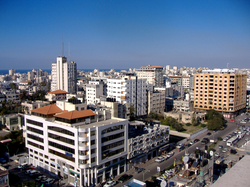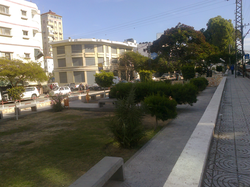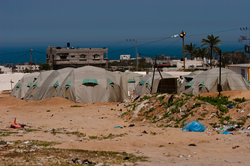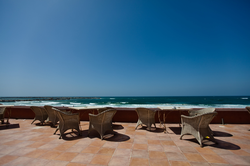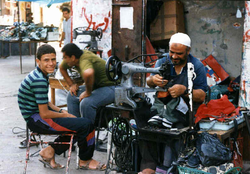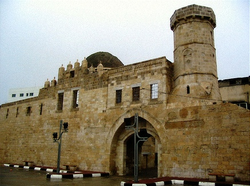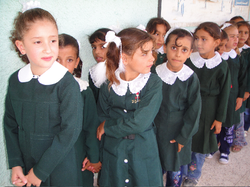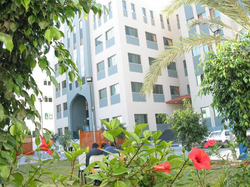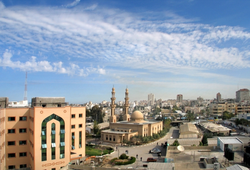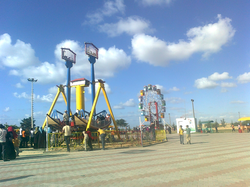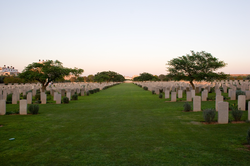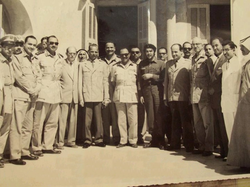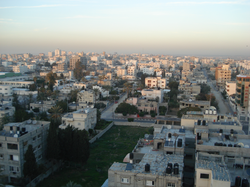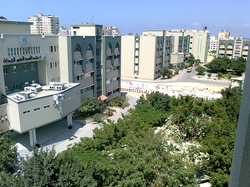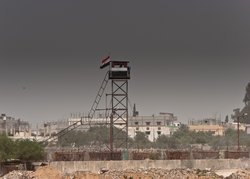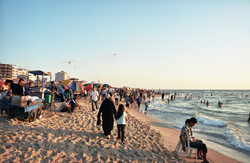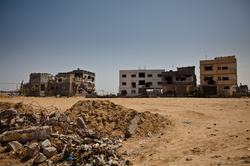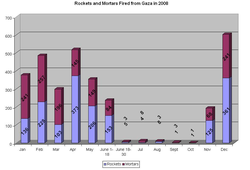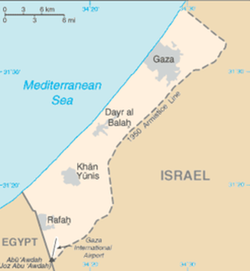Gaza Strip
Gaza Strip
| Status | • Part of thePalestinian Authorityaccording to theOslo Accords• Claimed byState of Palestine | |
| Largest city | Gaza | |
|---|---|---|
| Official languages | Arabic | |
| Ethnic groups | ||
| Demonym | Gazan | |
| Area | ||
| • | Total | 365 km141 sq mi |
| Population | ||
| • | End 2015 estimate | 1.85 million |
| • | Density | 5046/km13,069.1/sq mi |
| Currency | ||
| Time zone | ||
| • | Summer (DST) | (UTC+3) |
| Calling code | +970 | |
| TheState of Palestineisrecognized by 137 members of the United Nations. | ||
| Used since 1951. | ||
| Used since 1986; as in Israel, replaced theold Israeli shekel(1980–1985) and theIsraeli lira(1967–1980). | ||
The Gaza Strip (/ ˈ ɡ ɑː z ə ˈ s t r ɪ p /; Arabic : قطاع غزة Qiṭāʿ Ġazzah [qɪˈtˤɑːʕ ˈɣazza ] ), or simply Gaza, is a small self-governing Palestinian territory [undefined] [undefined] [undefined] [undefined] [undefined] [undefined] [undefined] on the eastern coast of the Mediterranean Sea, that borders Egypt on the southwest for 11 kilometers (6.8 mi) and Israel on the east and north along a 51 km (32 mi) border. Gaza, together with the West Bank, comprise the Palestinian territories claimed by the Palestinians as the future sovereign State of Palestine. The territories of Gaza and the West Bank are separated from each other by Israeli territory. Both fall under the jurisdiction of the Palestinian Authority, [undefined] but Gaza has since June 2007 been governed by Hamas, a Palestinian Islamic organization [undefined] which came to power in free elections in 2006. It has been placed under an Israeli and U.S.-led international economic and political boycott from that time onwards. [undefined]
The territory is 41 kilometers (25 mi) long, and from 6 to 12 kilometers (3.7 to 7.5 mi) wide, with a total area of 365 square kilometers (141 sq mi). [undefined] [undefined] With around 1.85 million Palestinians [undefined] on some 362 square kilometers, Gaza ranks as the 6th most densely populated polity in the world. [undefined] [undefined] An extensive Israeli buffer zone within the Strip renders much land off-limits to Gaza's Palestinians. [undefined] Gaza has an annual population growth rate of 2.91% (2014 est.), the 13th highest in the world, and is often referred to as overcrowded. [undefined] The population is expected to increase to 2.1 million in 2020. By that time, Gaza may be rendered unliveable, if present trends continue. [undefined] Due to the Israeli–Egyptian blockade, the population is not free to leave or enter the Gaza Strip, nor allowed to freely import or export goods. Sunni Muslims make up the predominant part of the Palestinian population in the Gaza Strip.
Despite the 2005 Israeli disengagement from Gaza, [undefined] the United Nations, International human rights organisations, and the majority of governments and legal commentators consider the territory to be still occupied by Israel, supported by additional restrictions placed on Gaza by Egypt. Israel maintains direct external control over Gaza and indirect control over life within Gaza: it controls Gaza's air and maritime space, and six of Gaza's seven land crossings. It reserves the right to enter Gaza at will with its military and maintains a no-go buffer zone within the Gaza territory. Gaza is dependent on Israel for its water, electricity, telecommunications, and other utilities. [undefined]
When Hamas won the Palestinian legislative election, 2006, Fatah refused to join the proposed coalition, until a short-lived unity government agreement was brokered by Saudi Arabia. When this collapsed under joint Israeli and United States pressure, the Palestinian Authority instituted a government in the West Bank while Hamas formed a government on its own in Gaza. [undefined] Further economic sanctions were imposed by Israel and the European Quartet against Hamas. A brief civil war between the two groups had broken out in Gaza when, apparently under a U.S.-backed plan, Fatah contested Hamas’s administration. Hamas emerged the victor and expelled Fatah-allied officials and members of the PA's security apparatus from the Strip, [undefined] [undefined] and has remained the sole governing power in Gaza since that date. [undefined]
| Status | • Part of thePalestinian Authorityaccording to theOslo Accords• Claimed byState of Palestine | |
| Largest city | Gaza | |
|---|---|---|
| Official languages | Arabic | |
| Ethnic groups | ||
| Demonym | Gazan | |
| Area | ||
| • | Total | 365 km141 sq mi |
| Population | ||
| • | End 2015 estimate | 1.85 million |
| • | Density | 5046/km13,069.1/sq mi |
| Currency | ||
| Time zone | ||
| • | Summer (DST) | (UTC+3) |
| Calling code | +970 | |
| TheState of Palestineisrecognized by 137 members of the United Nations. | ||
| Used since 1951. | ||
| Used since 1986; as in Israel, replaced theold Israeli shekel(1980–1985) and theIsraeli lira(1967–1980). | ||
Governance
Hamas government
The Hamas government of 2012 was the second Palestinian Hamas-dominated government, ruling over the Gaza Strip, since the split of the Palestinian National Authority in 2007. It was announced in early September 2012. [undefined] The reshuffle of the previous government was approved by Gaza-based Hamas MPs from the Palestinian Legislative Council (PLC) or parliament. [undefined]
Other political and militant groups in Gaza
The Islamic Jihad Movement in Palestine, also known as the Palestinian Islamic Jihad (PIJ) is a Palestinian militant organization operating in the West Bank and Gaza Strip. [undefined] The group has been labelled as a terrorist group by the United States, [undefined] the European Union, [undefined] the United Kingdom, [undefined] Japan, [undefined] Canada, [undefined] Australia [undefined] and Israel. Iran is a major financial supporter of the PIJ. [undefined] [undefined] Islamic Jihad is the second largest militant Islamic group in Gaza with 8,000 fighters present in the Gaza strip. [undefined] In June 2013, the Islamic Jihad broke ties with Hamas leaders after Hamas police fatally shot the commander of Islamic Jihad's military wing. [undefined]
Deal with Fatah
On September 25, 2014, Hamas agreed to let the Palestinian Authority resume control over the Gaza Strip and its border crossings with Egypt and Israel.
Status
Military occupation
The international community regards all of the Palestinian territories including Gaza as occupied. [undefined] Human Rights Watch has declared at the UN Human Rights Council that it views Israel as a de facto occupying power in the Gaza Strip, even though Israel has no military or other presence, because the Oslo Accord authorizes Israel to control the airspace and the territorial sea. [undefined] [undefined] [undefined]
In his statement on the 2008–2009 Israel–Gaza conflict, Richard Falk, United Nations Special Rapporteur wrote that international humanitarian law applied to Israel "in regard to the obligations of an Occupying Power and in the requirements of the laws of war." [undefined] Amnesty International, the World Health Organization, Oxfam, the International Committee of the Red Cross, The United Nations, the United Nations General Assembly, the UN Fact Finding Mission to Gaza, international human rights organizations, US government websites, the UK Foreign and Commonwealth Office, and a significant number of legal commentators (Geoffrey Aronson, Meron Benvenisti, Claude Bruderlein, Sari Bashi and Kenneth Mann, Shane Darcy and John Reynolds, Yoram Dinstein, John Dugard, Marc S. Kaliser, Mustafa Mari, Iain Scobbie, and Yuval Shany maintain that Israel's extensive direct external control over Gaza, and indirect control over the lives of its internal population mean that Gaza remained occupied. [undefined] [undefined]
Israel states that it does not exercise effective control or authority over any land or institutions in the Gaza Strip and thus the Gaza Strip is no longer subject to the former military occupation. [undefined] [undefined] Foreign Affairs Minister of Israel Tzipi Livni stated in January 2008: "Israel got out of Gaza. It dismantled its settlements there. No Israeli soldiers were left there after the disengagement." [undefined] In spite of Israel's withdrawal from Gaza in 2005, the Hamas Government in Gaza considers Gaza as occupied territory. [undefined]
Human rights organization Euro-Mediterranean Human Rights Monitor has set up the project "We Are Not Numbers", in which Gazans are encouraged to write their personal story as Palestinian living under occupation or in a refugee camp. [undefined]
Control over airspace
As agreed between Israel and the Palestinian Authority in the Oslo Accords, Israel has exclusive control over the airspace. It can interfere with radio and TV transmissions, and the Palestinian Authority cannot engage in independent initiatives for operating a seaport or airport. [undefined] The Accords also permitted Palestinians to construct an airport, which was duly built and opened in 1998. Israel destroyed Gaza's only airport in 2001 and 2002, during the Second Intifada. [undefined] [undefined]
The Israeli army makes use of drones, which can launch precise missiles. They are equipped with high-resolution cameras and other sensors. In addition, the missile fired from a drone has its own cameras that allow the operator to observe the target from the moment of firing. After a missile has been launched, the drone operator can remotely divert it elsewhere. Drone operators can view objects on the ground in detail during both day and night. [undefined] Israeli drones routinely patrol over Gaza.
Buffer Zone
Part of the territory is depopulated because of the imposition of buffer zones on both the Israeli and Egyptian borders.
Initially, Israel imposed a 50-meter buffer zone in Gaza.
[undefined] In 2000, it was expanded to 150 meters.
[undefined] Following the 2005 Israeli disengagement from Gaza, an undefined buffer zone was maintained, including a no-fishing zone along the coast.
In 2009/2010, Israel expanded the buffer zone to 300 meters.
[undefined] [undefined] [undefined] In 2010, the UN estimated that 30 percent of the arable land in Gaza had been lost to the buffer zone. [undefined] [undefined]
On 25 February 2013, pursuant to a November 2012 ceasefire, Israel declared a buffer zone of 100 meters on land and 6 nautical miles offshore.
In the following month, the zone was changed to 300 meters and 3 nautical miles.
The 1994 Gaza Jericho Agreement allows 20 nautical miles, and the 2002 Bertini Commitment allows 12 nautical miles. [undefined] [undefined]
In August 2015, the IDF confirmed a buffer zone of 300 meters for residents and 100 meters for farmers, but without explaining how to distinguish between the two.
[undefined] As of 2015, on a third of Gaza's agricultural land, residents risk Israeli attacks.
According to PCHR, Israeli attacks take place up to approximately 1.5 km (0.9 mi) from the border, making 17% of Gaza's total territory a risk zone. [undefined]
Israel says the buffer zone is needed to protect Israeli communities just over the border from sniper fire and rocket attacks.
In the 18 months until November 2010, one Thai farm worker in Israel was killed by a rocket fired from Gaza, and in 2010, according to IDF figures, 180 rockets and mortars had been fired into Israel by militants.
In 6 months, however, 11 Palestinians civilians, including four children, had been killed by Israeli fire and at least 70 Palestinian civilians were injured in the same period, including at least 49 who were working collecting rubble and scrap metal.
A buffer zone was also created on the Egyptian side of the Gaza–Egypt border. In 2014, scores of homes in Rafah were destroyed for the buffer zone. [undefined] According to Amnesty International, more than 800 homes had been destroyed and more than 1,000 families evicted. [undefined] Palestinian President Mahmoud Abbas agreed with the destruction of smuggling tunnels by flooding them, and then punishing the owners of the houses that contained entrances to the tunnels, including demolishing their houses, arguing that the tunnels had produced 1,800 millionaires, and were used for smuggling weapons, drugs, cash, and equipment for forging documents. [undefined]
Gaza blockade
Israel and Egypt maintain a blockade of the Gaza Strip, although Israel allows in limited quantities of medical humanitarian aid. The Red Cross claimed that the blockade harms the economy and causes a shortage of basic medicines and equipment such as painkillers and x-ray film. [undefined]
Israel claims the blockade is necessary to prevent the smuggling of weapons into Gaza.
For example, in 2014, a Panamanian-flagged ship claiming to be carrying construction materials was boarded by the IDF and was found to contain Syrian produced rockets.
[undefined] Israel maintains that the blockade is legal and necessary to limit Palestinian rocket attacks from the Gaza Strip on its cities and to prevent Hamas from obtaining other weapons. [undefined] [undefined] [undefined] [undefined] [undefined] [undefined]
Director of the Shin Bet (Israel Security Agency) Yuval Diskin did not oppose easing trade restrictions, but said that smuggling tunnels in Sinai and an open seaport in the Gaza Strip endangered Israel's security. According to Diskin, Hamas and Islamic Jihad had smuggled in over "5,000 rockets with ranges up to 40 km (25 mi)." Some of the rockets could reach as far as the Tel Aviv Metropolitan Area. [undefined]
Israeli spokesman Mark Regev described Israel's actions as "sanctions," not a blockade, but a Gazan legal consultant for UNRWA called the blockade "an action outside of international law.”
In July 2010, British Prime Minister David Cameron said, "humanitarian goods and people must flow in both directions. Gaza cannot and must not be allowed to remain a prison camp." [undefined] In response, the spokesman for the Israeli embassy in London said, "The people of Gaza are the prisoners of the terrorist organization Hamas. The situation in Gaza is the direct result of Hamas' rule and priorities."
The Arab League accused Israel of waging a financial war. [undefined] The IDF strictly controlled travel within the area of the crossing points between Israel and the Gaza Strip, and sealed its border with Gaza. U.S. government travel guides warned tourists that the region was dangerous.
Facing mounting international pressure, Egypt and Israel lessened the restrictions starting in June 2010, when the Rafah border crossing from Egypt to Gaza was partially opened by Egypt.
Egypt’s foreign ministry said that the crossing would remain open mainly for people, but not for supplies.
[undefined] Israel announced that it would allow the passage of civilian goods but not weapons and items that could be used for dual purposes.
[undefined] In December 2015, Egypt asked Israel not to allow Turkish aid to get through to the Gaza Strip.
[undefined] Benjamin Netanyahu said that it is impossible to lift the siege on Gaza and that the security of Israel is the primary issue for him.
He confirmed "that Israel is the only country that currently sends supplies to the coastal enclave".
In January and February 2011, the United Nations Office for the Coordination of Humanitarian Affairs (UNOCHA) assessed measures taken to ease the blockade [undefined] and concluded that they were helpful but not sufficient to improve the lives of the local inhabitants. [undefined] UNOCHA called on Israel to reduce restrictions on exports and the import of construction materials, and to lift the general ban on movement between Gaza and the West Bank via Israel. [undefined] After Egypt's President Hosni Mubarak resigned on 28 May 2011, Egypt permanently opened its border with the Gaza Strip to students, medical patients, and foreign passport holders. [undefined] [undefined] Following the 2013 Egyptian coup d'état, Egypt's military has destroyed most of the 1,200 tunnels which are used for smuggling food, weapons, and other goods to Gaza. [undefined] After the August 2013 Rabaa Massacre in Egypt, the border crossing was closed 'indefinitely.'[undefined]
Israel has alternately restricted or allowed goods and people to cross the terrestrial border and handles vicariously the movement of goods into and out of Gaza by air and sea. Israel largely provides for Gaza's water supply, electricity, and communications infrastructure. While the import of food is restricted through the Gaza blockade, the Israeli military destroys agricultural crops by spraying toxic chemicals over the Gazan lands, using aircraft flying over the border zone. [undefined] [undefined] Also Gaza's agricultural research and development station was destroyed in 2014 and again in January 2016, while import of new equipment is obstructed. [undefined]
Movement of people
Because of the Israeli–Egyptian blockade, the population is not free to leave or enter the Gaza Strip.
Only in exceptional cases are people allowed to pass through the Erez Crossing or the Rafah Border Crossing. [undefined] [undefined] [undefined] [undefined] In 2015, a Gazan woman was not allowed to travel through Israel to Jordan on her way to her own wedding. The Israeli authorities found she did not meet the criteria for travel, namely only in exceptional humanitarian cases. [undefined]
Under the long-term blockade, the Gaza Strip is often described as a "prison-camp or open air prison for its collective denizens."
The comparison is done by observers, ranging from Roger Cohen and Lawrence Weschler to NGOs, such as B'tselem, and politicians and diplomats, such as David Cameron, Noam Chomsky, Recep Tayyip Erdoğan, David Shoebridge and Sir John Holmes [undefined] [undefined] [undefined] [undefined] [undefined] [undefined] [undefined] [undefined] In 2014 French President Francois Hollande called for the demilitarization of Gaza and a lifting of the blockade, saying "Gaza must neither be an open prison nor a military base." [undefined]
An anonymous Israeli analyst has called it "Israel's Alcatraz." [undefined] While Lauren Booth, [undefined] [undefined] Philip Slater, [undefined] Giorgio Agamben [undefined] compare it to a "concentration camp." For Robert S. Wistrich, [undefined] and Philip Mendes, [undefined] such analogies are designed to offend Jews, while Philip Seib dismisses the comparison as absurd, and claims that it arises from sources like Al Jazeera and statements by Arab leaders. [undefined]
Economy
The economy of the Gaza Strip is severely hampered by Egypt and Israel's almost total blockade, the high population density, limited land access, strict internal and external security controls, the effects of Israeli military operations, and restrictions on labor and trade access across the border.
Per capita income (PPP) was estimated at US$3,100 in 2009, a position of 164th in the world. Seventy percent of the population is below the poverty line according to a 2009 estimate. Gaza Strip industries are generally small family businesses that produce textiles, soap, olive-wood carvings, and mother-of-pearl souvenirs.
The EU described the Gaza economy as follows: "Since Hamas took control of Gaza in 2007 and following the closure imposed by Israel, the situation in the Strip has been one of chronic need, de-development and donor dependency, despite a temporary relaxation on restrictions in movement of people and goods after the Gaza flotilla raid in 2010. The closure has effectively cut off access for exports to traditional markets in Israel, transfers to the West Bank and has severely restricted imports. Exports are now down to 2% of 2007 levels." [undefined]
According to Sara Roy, one senior IDF officer told an UNWRA official in 2015 that Israel's policy towards the Gaza Strip consisted of: "No development, no prosperity, no humanitarian crisis.”
After Oslo (1994-2007)
Economic output in the Gaza Strip declined by about one-third between 1992 and 1996.
This downturn was attributed to Israeli closure policies and, to a lesser extent, corruption and mismanagement by Yasser Arafat. Economic development has been hindered by Israel refusing to allow the operation of a sea harbour. A Gaza Seaport was planned to be built in Gaza with help from France and The Netherlands, but the project was bombed by Israel in 2001. Israel said that the reason for bombing was that Israeli settlements were being shot at from the construction site at the harbour. As a result, international transports (both trade and aid) had to go through Israel, which was hindered by the imposition of generalized border closures. These also disrupted previously established labor and commodity market relationships between Israel and the Strip. A serious negative social effect of this downturn was the emergence of high unemployment.
For its energy, Gaza is largely dependent on Israel either for import of electricity or fuel for its sole power plant.
The Oslo Accords set limits for the Palestinian production and importation of energy. Pursuant to the Accords, the Israel Electric Corporation exclusively supplies the electricity (63% of the total consumption in 2013). [undefined] The amount of electricity has consistently been limited to 120 megawatts, which is the amount Israel undertook to sell to Gaza pursuant to the Oslo Accords. [undefined]
Israel's use of comprehensive closures decreased over the next few years.
In 1998, Israel implemented new policies to ease security procedures and allow somewhat freer movement of Gazan goods and labor into Israel.
These changes led to three years of economic recovery in the Gaza Strip, disrupted by the outbreak of the al-Aqsa Intifada in the last quarter of 2000. Before the second Palestinian uprising in September 2000, around 25,000 workers from the Gaza Strip (about 2% of the population) worked in Israel on a daily basis. [undefined]
The Second Intifada led to a steep decline in the economy of Gaza, which was heavily reliant upon external markets. Israel—which had begun its occupation by helping Gazans to plant approximately 618,000 trees in 1968, and to improve seed selection—over the first 3-year period of the second intifada, destroyed 10 percent of Gazan agricultural land, and uprooted 226,000 trees. [undefined] The population became largely dependent on humanitarian assistance, primarily from UN agencies.
The al-Aqsa Intifada triggered tight IDF closures of the border with Israel, as well as frequent curbs on traffic in Palestinian self-rule areas, severely disrupting trade and labor movements. In 2001, and even more so in early 2002, internal turmoil and Israeli military measures led to widespread business closures and a sharp drop in GDP. Civilian infrastructure, such as the Palestine airport, was destroyed by Israel. [undefined] Another major factor was a drop in income due to reduction in the number of Gazans permitted entry to work in Israel. After the Israeli withdrawal from Gaza, the flow of a limited number of workers into Israel resumed, although Israel said it would reduce or end such permits due to the victory of Hamas in the 2006 parliamentary elections.
The Israeli settlers of Gush Katif built greenhouses and experimented with new forms of agriculture. These greenhouses provided employment for hundreds of Gazans. When Israel withdrew from the Gaza Strip in the summer of 2005, more than 3,000 (about half) of the greenhouses were purchased with $14 million raised by former World Bank president James Wolfensohn, and given to Palestinians to jump-start their economy. The rest were demolished by the departing settlers before there were offered a compensation as an inducement to leave them behind. [undefined] The farming effort faltered due to limited water supply, Palestinian looting, restrictions on exports, and corruption in the Palestinian Authority. Many Palestinian companies repaired the greenhouses damaged and looted by the Palestinians after the Israeli withdrawal. [undefined]
In 2005, after the Israeli withdrawal from the Gaza Strip, Gaza businessmen envisaged a "magnificent future."
$1.1 million was invested in an upscale restaurant, Roots, and plans were made to turn one of the Israeli settlements into a family resort.
Following Hamas takeover (2007-present)
The European Union states: "Gaza has experienced continuous economic decline since the imposition of a closure policy by Israel in 2007. This has had serious social and humanitarian consequences for many of its 1.7 million inhabitants. The situation has deteriorated further in recent months as a result of the geo-political changes which took place in the region during the course of 2013, particularly in Egypt and its closure of the majority of smuggling tunnels between Egypt and Gaza as well as increased restrictions at Rafah." [undefined] Israel, the United States, Canada, and the European Union have frozen all funds to the Palestinian government after the formation of a Hamas-controlled government after its democratic victory in the 2006 Palestinian legislative election. They view the group as a terrorist organization, and have pressured Hamas to recognize Israel, renounce violence, and make good on past agreements. Prior to disengagement, 120,000 Palestinians from Gaza had been employed in Israel or in joint projects. After the Israeli withdrawal, the gross domestic product of the Gaza Strip declined. Jewish enterprises shut down, work relationships were severed, and job opportunities in Israel dried up. After the 2006 elections, fighting broke out between Fatah and Hamas, which Hamas won in the Gaza Strip on 14 June 2007. Israel imposed a blockade, and the only goods permitted into the Strip through the land crossings were goods of a humanitarian nature, and these were permitted in limited quantities.
An easing of Israel's closure policy in 2010 resulted in an improvement in some economic indicators, although exports were still restricted.
According to the Israeli Defense Forces and the Palestinian Central Bureau of Statistics, the economy of the Gaza Strip improved in 2011, with a drop in unemployment and an increase in GDP. New malls opened and local industry began to develop. This economic upswing has led to the construction of hotels and a rise in the import of cars. [undefined] Wide-scale development has been made possible by the unhindered movement of goods into Gaza through the Kerem Shalom Crossing and tunnels between the Gaza Strip and Egypt. The current rate of trucks entering Gaza through Kerem Shalom is 250 trucks per day. The increase in building activity has led to a shortage of construction workers. To make up for the deficit, young people are being sent to learn the trade in Turkey. [undefined]
In 2012, Hamas leader Mahmoud Zahar said that Gaza's economic situation has improved and Gaza has become self-reliant "in several aspects except petroleum and electricity" despite Israel's blockade. Zahar said that Gaza's economic conditions are better than those in the West Bank. [undefined] In 2014, the EU's opinion was: "Today, Gaza is facing a dangerous and pressing humanitarian and economic situation with power outages across Gaza for up to 16 hours a day and, as a consequence, the closure of sewage pumping operations, reduced access to clean water; a reduction in medical supplies and equipment; the cessation of imports of construction materials; rising unemployment, rising prices and increased food insecurity. If left unaddressed, the situation could have serious consequences for stability in Gaza, for security more widely in the region as well as for the peace process itself." [undefined]
2012 fuel crisis
Usually, diesel for Gaza came from Israel, [undefined] but in 2011, Hamas started to buy cheaper fuel from Egypt, bringing it via a network of underground tunnels, and refused to allow it from Israel.
In early 2012, due to internal economic disagreement between the Palestinian Authority and the Hamas Government in Gaza, decreased supplies from Egypt and through tunnel smuggling, and Hamas's refusal to ship fuel via Israel, the Gaza Strip plunged into a fuel crisis, bringing increasingly long electricity shut downs and disruption of transportation.
Egypt had attempted for a while to stop the use of underground tunnels for delivery of Egyptian fuel purchased by Palestinian authorities, and had severely reduced supply through the tunnel network.
As the crisis broke out, Hamas sought to equip the Rafah terminal between Egypt and Gaza for fuel transfer, and refused to accept fuel to be delivered via the Kerem Shalom crossing between Israel and Gaza.
In mid-February 2012, as the crisis escalated, Hamas rejected an Egyptian proposal to bring in fuel via the Kerem Shalom Crossing between Israel and Gaza to reactivate Gaza’s only power plant. Ahmed Abu Al-Amreen of the Hamas-run Energy Authority refused it on the grounds that the crossing is operated by Israel and Hamas' fierce opposition to the existence of Israel. Egypt cannot ship diesel fuel to Gaza directly through the Rafah crossing point, because it is limited to the movement of individuals. [undefined]
In early March 2012, the head of Gaza's energy authority stated that Egypt wanted to transfer energy via the Kerem Shalom Crossing, but he personally refused it to go through the "Zionist entity" (Israel) and insisted that Egypt transfer the fuel through the Rafah Crossing, although this crossing is not equipped to handle the half-million liters needed each day. [undefined]
In late March 2012, Hamas began offering carpools for people to use Hamas state vehicles to get to work.
Many Gazans began to wonder how these vehicles have fuel themselves, as diesel was completely unavailable in Gaza, ambulances could no longer be used, but Hamas government officials still had fuel for their own cars.
Many Gazans said that Hamas confiscated the fuel it needed from petrol stations and used it exclusively for their own purposes.
Egypt agreed to provide 600,000 liters of fuel to Gaza daily, but it had no way of delivering it that Hamas would agree to.
In addition, Israel introduced a number of goods and vehicles into the Gaza Strip via the Kerem Shalom Crossing, as well as the normal diesel for hospitals.
Israel also shipped 150,000 liters of diesel through the crossing, which was paid for by the Red Cross.
In April 2012, the issue was resolved as certain amounts of fuel were supplied with the involvement of the Red Cross, after the Palestinian Authority and Hamas reached a deal. Fuel was finally transferred via the Israeli Kerem Shalom Crossing, which Hamas previously refused to transfer fuel from. [undefined]
Current budget
Most of the Gaza Strip administration funding comes from outside as an aid, with large portion delivered by UN organizations directly to education and food supply.
Most of the Gaza GDP comes as foreign humanitarian and direct economic support.
Of those funds, the major part is supported by the U.S. and the European Union.
Portions of the direct economic support have been provided by the Arab League, though it largely has not provided funds according to schedule.
Among other alleged sources of Gaza administration budget is Iran.
A diplomatic source told Reuters that Iran had funded Hamas in the past with up to $300 million per year, but the flow of money had not been regular in 2011.
"Payment has been in suspension since August," said the source.
On January 2012, some diplomatic sources said that Turkey promised to provide Haniyeh's Gaza Strip administration with $300 million to support its annual budget.
On April 2012, the Hamas government in Gaza approved its budget for 2012, which was up 25 percent year-on-year over 2011 budget, indicating that donors, including Iran, benefactors in the Islamic world, and Palestinian expatriates, are still heavily funding the movement.
[undefined] Chief of Gaza's parliament's budget committee Jamal Nassar said the 2012 budget is $769 million, compared to $630 million in 2011.
Geography and climate
The Gaza Strip is located in the Middle East (at ). It has a 51 kilometers (32 mi) border with Israel, and an 11 km (7 mi) border with Egypt, near the city of Rafah. Khan Yunis is located 7 kilometers (4.3 mi) northeast of Rafah, and several towns around Deir el-Balah are located along the coast between it and Gaza City. Beit Lahia and Beit Hanoun are located to the north and northeast of Gaza City, respectively. The Gush Katif bloc of Israeli settlements used to exist on the sand dunes adjacent to Rafah and Khan Yunis, along the southwestern edge of the 40 kilometers (25 mi) Mediterranean coastline. Al Deira beach is a popular venue for surfers. [undefined]
The Gaza Strip has an arid climate, with mild winters, and dry, hot summers subject to drought. The terrain is flat or rolling, with dunes near the coast. The highest point is Abu 'Awdah (Joz Abu 'Auda), at 105 meters (344 ft) above sea level. Environmental problems include desertification; salination of fresh water; sewage treatment; water-borne diseases; soil degradation; and depletion and contamination of underground water resources.

